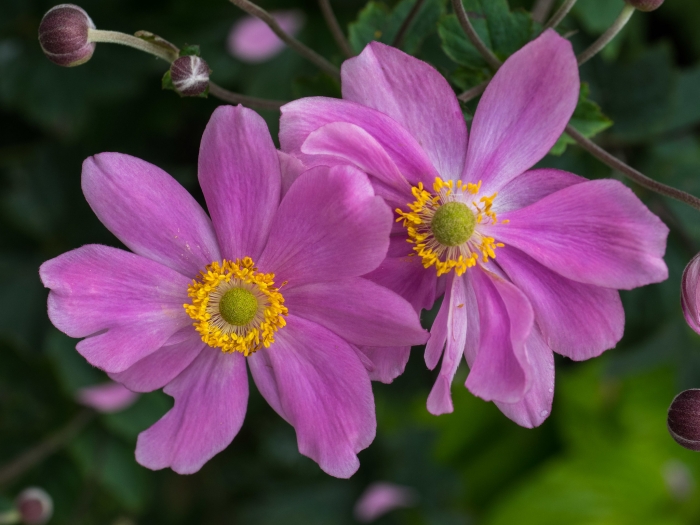Japanese Anemone
(Anemone hybrida)
Japanese Anemone (Anemone hybrida)
/
/

F. D. Richards
CC BY-SA 2.0
Image By:
F. D. Richards
Recorded By:
Copyright:
CC BY-SA 2.0
Copyright Notice:
Photo by: F. D. Richards | License Type: CC BY-SA 2.0 | License URL: https://creativecommons.org/licenses/by/2.0/ | Uploader: F. D. Richards | Publisher: Flickr |































Estimated Native Range
Summary
Anemone hybrida, commonly known as Japanese Anemone, is a hybrid deciduous perennial herb originating from garden cultivations, first released in 1858. It is derived from species that typically grow in meadows and at forest edges in China and Japan. Japanese Anemone reaches up to 1.5 meters (4.9 feet) in height and forms large clumps of dark green, ternate, basal leaves on long petioles. The inflorescence is a large, loose cyme with semi-double flowers that bloom from late summer to fall. Each flower is approximately 8 cm (3.1 in) across with 7–11 white, pink, or rose sepals (no true petals) that have a silky sheen on the backside, encircling a center of prominent golden stamens, creating a showy display.
The plant is valued for its late-season blooms, which add color to gardens when many other flowers have finished blooming. It is commonly used in border plantings, woodland gardens, and as a ground cover due to its clumping habit. Japanese Anemone thrives in part shade, requiring medium amounts of water and well-draining soil. While it is generally low maintenance, it can be prone to foliar diseases such as powdery mildew and rust. Additionally, it can spread aggressively by rhizomes, which should be considered when planting in small spaces or near natural areas to prevent unwanted spread.CC BY-SA 4.0
The plant is valued for its late-season blooms, which add color to gardens when many other flowers have finished blooming. It is commonly used in border plantings, woodland gardens, and as a ground cover due to its clumping habit. Japanese Anemone thrives in part shade, requiring medium amounts of water and well-draining soil. While it is generally low maintenance, it can be prone to foliar diseases such as powdery mildew and rust. Additionally, it can spread aggressively by rhizomes, which should be considered when planting in small spaces or near natural areas to prevent unwanted spread.CC BY-SA 4.0
Plant Description
- Plant Type: Herb
- Height: 3-4 feet
- Width: 2-3 feet
- Growth Rate: Moderate
- Flower Color: Pink, White
- Flowering Season: Summer, Fall
- Leaf Retention: Deciduous
Growth Requirements
- Sun: Part Shade
- Water: Medium
- Drainage: Fast
Common Uses
Bee Garden, Bird Garden, Border Plant, Butterfly Garden, Deer Resistant, Drought Tolerant, Groundcover, Low Maintenance, Potted Plant, Rabbit Resistant, Rock Garden, Salt Tolerant, Showy Flowers
Natural Habitat
Derived from species native to meadows and forest edges in China and Japan
Other Names
Common Names: Windflower , Thimbleflower
Scientific Names: Anemone hybrida
GBIF Accepted Name: Anemone hybrida hort. ex E.Vilm., 1863